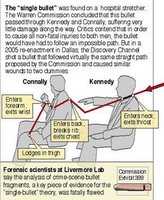 from contra costa times: More than four decades after his death, John F. Kennedy's assassination remains the hottest cold case in U.S. history, and the clues continue to trickle in. Now Lawrence Livermore Laboratory scientists say a key piece of evidence supporting the lone gunman theory should be thrown out.
from contra costa times: More than four decades after his death, John F. Kennedy's assassination remains the hottest cold case in U.S. history, and the clues continue to trickle in. Now Lawrence Livermore Laboratory scientists say a key piece of evidence supporting the lone gunman theory should be thrown out.A new look at clues gleaned from studies of crime-scene bullet fragments shows they may have been misinterpreted.
"It basically shatters what some people call the best physical evidence around," said chemist Pat Grant, director of the lab's Forensic Science Center.
Grant and Livermore Lab metallurgist Erik Randich found that the chemical "fingerprints" used to identify which bullets the fragments came from are actually more like run-of-the-mill tire tracks than one-of-a-kind fingerprints.
"I've spoken with people on both sides of the conspiracy divide and there's no question but that (Randich and Grant's) work is going to be very difficult, if not outright impossible, to refute," said Gary Aguilar, a San Francisco ophthalmologist and single-bullet skeptic who has studied the Kennedy assassination for more than a decade. "It looks impregnable."
The government's claim that Lee Harvey Oswald alone killed Kennedy spawned a vitriolic debate between conspiracy theorists and lone gunman supporters that rages to this day.
No comments:
Post a Comment